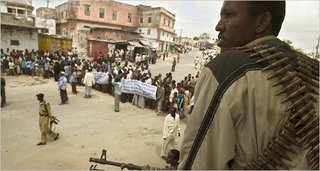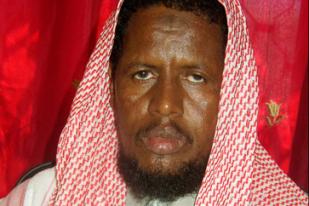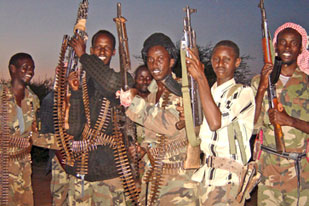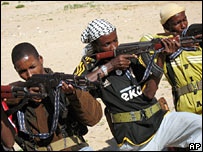Oxfam warned of a new humanitarian crisis reversing months of progress if better efforts were not made to bring the LRA back to the negotiating table after they quit talks in south Sudan
Read
moreSouth Sudan pulls out of mediation role
****************************
Monday, 15 January, 2007
Joseph Kony, the leader of the LRA, has left southern Sudan together with his troops that had assembled at Ri-Kwangba, one of the two designated assembly points. LRA deputy commander Vincent Otti reported this on Saturday, also saying that the LRA are committed to peace talks, but that nothing Khartoum can say or do will lure them back to negotiations in Sudan. "We have gone back to our hideout in Congo. I am considering ordering my forces in Southern Sudan to retreat back to Uganda if attacks on them are not stopped," Otti said. Otti claimed that the UPDF has been attacking LRA positions in South Sudan.
*************************************
Friday, 12 January, 2007
The peace talks between the
Ugandan government and rebels of the Lord's Resistance Army (LRA) are faltering following a walkout of the LRA delegation which cited frequent attacks by the Ugandan army as the reason.
read more
here from the
People's Daily ( China)
The LRA has pulled out of talks again.
I Suspect this has more to do with Cony's war crime indictments, and the goverment's refusal to assist with amnsety, but lets wait and see.
-Shimron
***********************************
UGANDA: Rebels want review of ceasefire, alleging new attacks
KAMPALA, 17 Oct 2006 (IRIN) - The Lord’s Resistance Army (LRA) on Tuesday demanded an urgent review of its ceasefire agreement with the Ugandan government, claiming that the army had opened fire on rebel fighters on their way to an assembly point in southern Sudan."We want the agreement to be reviewed so that the SPLA [the army of the government of southern Sudan] should tell us whether they are able to provide security to our forces and whether the [Ugandan] government is willing to abide by the agreement," said Ayena Odongo, legal adviser to the LRA delegation at the peace talks in Juba, the capital of southern Sudan.
read the rest.News from an August posting by ICT.org:
Tabliqi Groups in Uganda – the Allied Democratic Forces
On April 18, 2003, a cache of files recovered from the bombed-out headquarters of Iraq's intelligence agency showed that Saddam Hussein's regime had links to an Islamist terror group in Africa – and had corresponded about opening a Baghdad training camp for the group. In one document written in English, a terror leader in Uganda vowed to attack the United States and its allies without rest. Bekkah Abdul Nasser, self-described chief of diplomacy of the Allied Democratic Front (ADF) guerilla group, wrote to his Iraqi contacts that "we should deliberately drive panic into them, their bases, and their interests. We do this in Africa; you do this in the Middle East, the Gulf, and Asia".1
In 2001, over a period of several months, a high-level ADF member outlined his group's progress to Fallah Hassan al-Rubdie, an Iraqi chargé d'affaires based in Nairobi, Kenya.
Read more.____________________________________________
-From the CIA world fact book
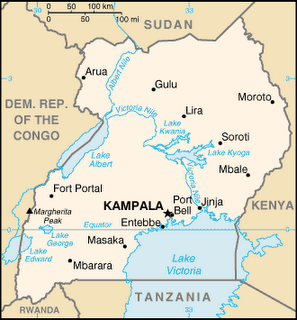
The colonial boundaries created by Britain to delimit Uganda grouped together a wide range of ethnic groups with different political systems and cultures.
These differences prevented the establishment of a working political community after independence was achieved in 1962. The dictatorial regime of Idi AMIN (1971-79) was responsible for the deaths of some 300,000 opponents; guerrilla war and human rights abuses under Milton OBOTE (1980-85) claimed at least another 100,000 lives. The rule of Yoweri MUSEVENI since 1986 has brought relative stability and economic growth to Uganda. During the 1990s, the government promulgated non-party presidential and legislative elections.
GeographyUganda
Top of PageLocation:
Eastern Africa, west of Kenya
Geographic coordinates:
1 00 N, 32 00 E
Map references:
AfricaArea:
total: 236,040 sq km land: 199,710 sq km water: 36,330 sq km
Area - comparative:
slightly smaller than Oregon
Land boundaries:
total: 2,698 km border countries: Democratic Republic of the Congo 765 km, Kenya 933 km, Rwanda 169 km, Sudan 435 km, Tanzania 396 km
Coastline:
0 km (landlocked)
Maritime claims:
none (landlocked)
Climate:
tropical; generally rainy with two dry seasons (December to February, June to August); semiarid in northeast
Terrain:
mostly plateau with rim of mountains
Elevation extremes:
lowest point: Lake Albert 621 m highest point: Margherita Peak on Mount Stanley 5,110 m
Natural resources:
copper, cobalt, hydropower, limestone, salt, arable land
Land use:
arable land: 21.57% permanent crops: 8.92% other: 69.51% (2005)
Irrigated land:
90 sq km (2003)
Natural hazards:
NA
Environment - current issues:
draining of wetlands for agricultural use; deforestation; overgrazing; soil erosion; water hyacinth infestation in Lake Victoria; poaching is widespread
Environment - international agreements:
party to: Biodiversity, Climate Change, Climate Change-Kyoto Protocol, Desertification, Endangered Species, Hazardous Wastes, Law of the Sea, Marine Life Conservation, Ozone Layer Protection, Wetlands signed, but not ratified: Environmental Modification
Geography - note:
landlocked; fertile, well-watered country with many lakes and rivers
PeopleUganda
Top of PagePopulation:
28,195,754 note: estimates for this country explicitly take into account the effects of excess mortality due to AIDS; this can result in lower life expectancy, higher infant mortality and death rates, lower population and growth rates, and changes in the distribution of population by age and sex than would otherwise be expected (July 2006 est.)
Age structure:
0-14 years: 50% (male 7,091,763/female 6,996,385) 15-64 years: 47.8% (male 6,762,071/female 6,727,230) 65 years and over: 2.2% (male 266,931/female 351,374) (2006 est.)
Median age:
total: 15 years male: 14.9 years female: 15.1 years (2006 est.)
Population growth rate:
3.37% (2006 est.)
Birth rate:
47.35 births/1,000 population (2006 est.)
Death rate:
12.24 deaths/1,000 population (2006 est.)
Net migration rate:
-1.4 migrant(s)/1,000 population (2006 est.)
Sex ratio:
at birth: 1.03 male(s)/female under 15 years: 1.01 male(s)/female 15-64 years: 1.01 male(s)/female 65 years and over: 0.76 male(s)/female total population: 1 male(s)/female (2006 est.)
Infant mortality rate:
total: 66.15 deaths/1,000 live births male: 69.51 deaths/1,000 live births female: 62.69 deaths/1,000 live births (2006 est.)
Life expectancy at birth:
total population: 52.67 years male: 51.68 years female: 53.69 years (2006 est.)
Total fertility rate:
6.71 children born/woman (2006 est.)
HIV/AIDS - adult prevalence rate:
4.1% (2003 est.)
HIV/AIDS - people living with HIV/AIDS:
530,000 (2001 est.)
HIV/AIDS - deaths:
78,000 (2003 est.)
Major infectious diseases:
degree of risk: very high food or waterborne diseases: bacterial diarrhea, hepatitis A, and typhoid fever vectorborne diseases: malaria and African trypanosomiasis (sleeping sickness) are high risks in some locations water contact disease: schistosomiasis (2005)
Nationality:
noun: Ugandan(s) adjective: Ugandan
Ethnic groups:
Baganda 17%, Ankole 8%, Basoga 8%, Iteso 8%, Bakiga 7%, Langi 6%, Rwanda 6%, Bagisu 5%, Acholi 4%, Lugbara 4%, Batoro 3%, Bunyoro 3%, Alur 2%, Bagwere 2%, Bakonjo 2%, Jopodhola 2%, Karamojong 2%, Rundi 2%, non-African (European, Asian, Arab) 1%, other 8%
Religions:
Roman Catholic 33%, Protestant 33%, Muslim 16%, indigenous beliefs 18%
Languages:
English (official national language, taught in grade schools, used in courts of law and by most newspapers and some radio broadcasts), Ganda or Luganda (most widely used of the Niger-Congo languages, preferred for native language publications in the capital and may be taught in school), other Niger-Congo languages, Nilo-Saharan languages, Swahili, Arabic
Literacy:
definition: age 15 and over can read and write total population: 69.9% male: 79.5% female: 60.4% (2003 est.)
GovernmentUganda
Top of PageCountry name:
conventional long form: Republic of Uganda conventional short form: Uganda local long form: Republic of Uganda local short form: Uganda
Government type:
republic
Capital:
name: Kampala geographic coordinates: 0 19 N, 32 25 E time difference: UTC+3 (8 hours ahead of Washington, DC during Standard Time)
Administrative divisions:
56 districts; Adjumani, Apac, Arua, Bugiri, Bundibugyo, Bushenyi, Busia, Gulu, Hoima, Iganga, Jinja, Kabale, Kabarole, Kaberamaido, Kalangala, Kampala, Kamuli, Kamwenge, Kanungu, Kapchorwa, Kasese, Katakwi, Kayunga, Kibale, Kiboga, Kisoro, Kitgum, Kotido, Kumi, Kyenjojo, Lira, Luwero, Masaka, Masindi, Mayuge, Mbale, Mbarara, Moroto, Moyo, Mpigi, Mubende, Mukono, Nakapiripirit, Nakasongola, Nebbi, Ntungamo, Pader, Pallisa, Rakai, Rukungiri, Sembabule, Sironko, Soroti, Tororo, Wakiso, Yumbe note: as of a July 2005, 13 new districts were reportedly added bringing the total up to 69; the new districts are Amolatar, Amuria, Budaka, Butaleja, Ibanda, Kaabong, Kabingo, Kaliro, Kiruhura, Koboko, Manafwa, Mityana, Nakaseke; a total of nine more districts are in the process of being added
Independence:
9 October 1962 (from UK)
National holiday:
Independence Day, 9 October (1962)
Constitution:
8 October 1995
Legal system:
in 1995, the government restored the legal system to one based on English common law and customary law; accepts compulsory ICJ jurisdiction, with reservations
Suffrage:
18 years of age; universal
Executive branch:
chief of state: President Lt. Gen. Yoweri Kaguta MUSEVENI (since seizing power 26 January 1986); note - the president is both chief of state and head of government head of government: President Lt. Gen. Yoweri Kaguta MUSEVENI (since seizing power 29 January 1986); Prime Minister Apollo NSIBAMBI (since 5 April 1999); note - the president is both chief of state and head of government; the prime minister assists the president in the supervision of the cabinet cabinet: Cabinet appointed by the president from among elected legislators elections: president reelected by popular vote for a five-year term; election last held 23 February 2006 (next to be held in 2011) election results: Lt. Gen. Yoweri Kaguta MUSEVENI elected president; percent of vote - Lt. Gen. Yoweri Kaguta MUSEVENI 59.3%, Kizza BESIGYE 37.4%, other 3.3%
Legislative branch:
unicameral National Assembly (303 members - 214 directly elected by popular vote, 81 nominated by legally established special interest groups [women 56, army 10, disabled 5, youth 5, labor 5], 8 ex officio members; members serve five-year terms) elections: last held 23 February 2006 (next to be held in 2011) election results: percent of vote by party - NA%; seats by party - NA; note - election results had not been posted as of March 2006
Judicial branch:
Court of Appeal (judges are appointed by the president and approved by the legislature); High Court (judges are appointed by the president)
Political parties and leaders:
Conservative Party or CP [Ken LUKYAMUZI]; Democratic Party or DP [Kizito SSEBAANA]; Forum for Democratic Change or FDC [Kizza BESIGYE]; Justice Forum or JEEMA [Muhammad Kibirige MAYANJA]; National Democrats Forum [Chapaa KARUHANGA]; National Resistance Movement or NRM [Yoweri MUSEVENI]; Ugandan People's Congress or UPC [Miria OBOTE] note: a national referendum in July 2005 opened the way for Uganda's transition to a multi-party political system
Political pressure groups and leaders:
Popular Resistance Against a Life President or PRALP
International organization participation:
ACP, AfDB, AU, C, COMESA, EADB, FAO, G-77, IAEA, IBRD, ICAO, ICCt, ICFTU, ICRM, IDA, IDB, IFAD, IFC, IFRCS, IGAD, ILO, IMF, Interpol, IOC, IOM, IPU, ISO (correspondent), ITU, MIGA, NAM, OIC, OPCW, PCA, UN, UNCTAD, UNESCO, UNHCR, UNIDO, UNMIS, UNOCI, UPU, WCO, WFTU, WHO, WIPO, WMO, WToO, WTO
Diplomatic representation in the US:
chief of mission: Ambassador Edith G. SSEMPALA chancery: 5911 16th Street NW, Washington, DC 20011 telephone: [1] (202) 726-7100 through 7102, 0416 FAX: [1] (202) 726-1727
Diplomatic representation from the US:
chief of mission: Ambassador (vacant); Charge d'Affaires William FITZGERALD embassy: 1577 Ggaba Rd., Kampala mailing address: P. O. Box 7007, Kampala telephone: [256] (41) 234-142 FAX: [256] (41) 258-451
Flag description:
six equal horizontal bands of black (top), yellow, red, black, yellow, and red; a white disk is superimposed at the center and depicts a red-crested crane (the national symbol) facing the hoist side
EconomyUganda
Top of PageEconomy - overview:
Uganda has substantial natural resources, including fertile soils, regular rainfall, and sizable mineral deposits of copper and cobalt. Agriculture is the most important sector of the economy, employing over 80% of the work force. Coffee accounts for the bulk of export revenues. Since 1986, the government - with the support of foreign countries and international agencies - has acted to rehabilitate and stabilize the economy by undertaking currency reform, raising producer prices on export crops, increasing prices of petroleum products, and improving civil service wages. The policy changes are especially aimed at dampening inflation and boosting production and export earnings. During 1990-2001, the economy turned in a solid performance based on continued investment in the rehabilitation of infrastructure, improved incentives for production and exports, reduced inflation, gradually improved domestic security, and the return of exiled Indian-Ugandan entrepreneurs. In 2000, Uganda qualified for enhanced Highly Indebted Poor Countries (HIPC) debt relief worth $1.3 billion and Paris Club debt relief worth $145 million. These amounts combined with the original HIPC debt relief added up to about $2 billion. Growth for 2001-02 was solid despite continued decline in the price of coffee, Uganda's principal export. Growth in 2003-05 reflected an upturn in Uganda's export markets.
GDP (purchasing power parity):
$48.73 billion (2005 est.)
GDP (official exchange rate):
$7.909 billion (2005 est.)
GDP - real growth rate:
4% (2005 est.)
GDP - per capita (PPP):
$1,800 (2005 est.)
GDP - composition by sector:
agriculture: 31.1% industry: 22.2% services: 46.9% (2004 est.)
Labor force:
13.17 million (2005 est.)
Labor force - by occupation:
agriculture: 82% industry: 5% services: 13% (1999 est.)
Unemployment rate:
NA%
Population below poverty line:
35% (2001 est.)
Household income or consumption by percentage share:
lowest 10%: 4% highest 10%: 21% (2000)
Distribution of family income - Gini index:
43 (1999)
Inflation rate (consumer prices):
8.1% (2005 est.)
Investment (gross fixed):
23.4% of GDP (2005 est.)
Budget:
revenues: $1.845 billion expenditures: $1.904 billion; including capital expenditures of $NA (2005 est.)
Public debt:
64.3% of GDP (2005 est.)
Agriculture - products:
coffee, tea, cotton, tobacco, cassava (tapioca), potatoes, corn, millet, pulses, cut flowers; beef, goat meat, milk, poultry
Industries:
sugar, brewing, tobacco, cotton textiles; cement, steel production
Industrial production growth rate:
9% (2005 est.)
Electricity - production:
1.729 billion kWh (2003)
Electricity - consumption:
1.448 billion kWh (2003)
Electricity - exports:
160 million kWh (2003)
Electricity - imports:
0 kWh (2003)
Oil - production:
0 bbl/day (2003 est.)
Oil - consumption:
10,000 bbl/day (2003 est.)
Oil - exports:
NA bbl/day
Oil - imports:
NA bbl/day
Natural gas - production:
0 cu m (2003 est.)
Natural gas - consumption:
0 cu m (2003 est.)
Current account balance:
-$355 million (2005 est.)
Exports:
$768 million f.o.b. (2005 est.)
Exports - commodities:
coffee, fish and fish products, tea, cotton, flowers, horticultural products; gold
Exports - partners:
Kenya 15.5%, Belgium 9.8%, Netherlands 9.6%, France 7%, Germany 4.9%, Rwanda 4.1% (2005)
Imports:
$1.608 billion f.o.b. (2005 est.)
Imports - commodities:
capital equipment, vehicles, petroleum, medical supplies; cereals
Imports - partners:
Kenya 33.2%, UAE 7.9%, South Africa 6.7%, India 6%, China 5.2%, UK 4.4%, US 4.1% (2005)
Reserves of foreign exchange and gold:
$1.286 billion (2005 est.)
Debt - external:
$4.973 billion (2005 est.)
Economic aid - recipient:
$959 million (2003)
Currency (code):
Ugandan shilling (UGX)
Exchange rates:
Ugandan shillings per US dollar - 1,780.7 (2005), 1,810.3 (2004), 1,963.7 (2003), 1,797.6 (2002), 1,755.7 (2001)
Fiscal year:
1 July - 30 June
CommunicationsUganda
Top of PageTelephones - main lines in use:
100,800 (2005)
Telephones - mobile cellular:
1.165 million (2004)
Telephone system:
general assessment: seriously inadequate; two cellular systems have been introduced, but a sharp increase in the number of main lines is essential; e-mail and Internet services are available domestic: intercity traffic by wire, microwave radio relay, and radiotelephone communication stations, fixed and mobile cellular systems for short-range traffic international: country code - 256; satellite earth stations - 1 Intelsat (Atlantic Ocean) and 1 Inmarsat; analog links to Kenya and Tanzania
Radio broadcast stations:
AM 7, FM 33, shortwave 2 (2001)
Television broadcast stations:
8 (plus one low-power repeater) (2001)
Internet country code:
.ug
Internet hosts:
2,496 (2005)
Internet users:
200,000 (2005)
TransportationUganda
Top of PageAirports:
31 (2006)
Airports - with paved runways:
total: 5 over 3,047 m: 3 1,524 to 2,437 m: 1 914 to 1,523 m: 1 (2006)
Airports - with unpaved runways:
total: 26 2,438 to 3,047 m: 1 1,524 to 2,437 m: 6 914 to 1,523 m: 11 under 914 m: 8 (2006)
Railways:
total: 1,244 km narrow gauge: 1,244 km 1.000-m gauge (2005)
Roadways:
total: 70,746 km paved: 16,272 km unpaved: 54,474 km (2003)
Waterways:
on Lake Victoria, 200 km on Lake Albert, Lake Kyoga, and parts of Albert Nile (2005)
Ports and terminals:
Entebbe, Jinja, Port Bell
MilitaryUganda
Top of PageMilitary branches:
Ugandan Peoples' Defense Force (UPDF): Army, Marine Unit, Air Wing
Military service age and obligation:
18 years of age for compulsory and voluntary military duty; the government has stated that recruitment below that age could occur with proper consent and that "no person under the apparent age of 13 years shall be enrolled in the armed forces"
Manpower available for military service:
males age 18-49: 5,012,620 females age 18-49: 4,855,858 (2005 est.)
Manpower fit for military service:
males age 18-49: 2,889,808 females age 18-49: 2,780,135 (2005 est.)
Military expenditures - dollar figure:
$192.8 million (2005 est.)
Military expenditures - percent of GDP:
2.2% (2005 est.)
Transnational IssuesUganda
Top of PageDisputes - international:
Uganda is subject to armed fighting among hostile ethnic groups, rebels, armed gangs, militias, and various government forces; Ugandan refugees have fled the Lord's Resistance Army (LRA) into the southern Sudan and the Democratic Republic of the Congo; LRA forces have attacked Kenyan villages across the border
Refugees and internally displaced persons:
refugees (country of origin): 214,673 (Sudan) 18,902 (Rwanda) 14,982 (Democratic Republic of Congo) IDPs: 1,330,000-2,000,000 note - ongoing Lord's Resistance Army (LRA) rebellion, mainly in the north; LRA frequently attacks IDP camps (2005)
This is from the US State Department's 2005 report on
religious freedoms:The Constitution provides for freedom of religion; however, in practice the Government imposed some minor restrictions.
There was no change in the status of respect for religious freedom during the period covered by this report, and government policy continued to contribute to the generally free practice of religion; however, local authorities prevented some nighttime religious meetings for security reasons.
The generally amicable relationship among religions in society contributed to religious freedom; however, a proposed Domestic Relations Bill that includes new restrictions on the practice of polygyny drew thousands of Muslims to the streets in peaceful protest during the period covered by this report.
The U.S. Government discusses religious freedom issues with the Government as part of its overall policy to promote human rights; it is also active in sponsoring efforts to promote dialogue and harmony among religious groups.
Section I. Religious Demography
The country has an area of 93,070 square miles, and its population is approximately 26.7 million. Christians constitute approximately 85 percent of the population. Muslims comprise approximately 12 percent of the population. A variety of other religions, including traditional indigenous religions, Hinduism, the Baha'i Faith, and Judaism, are practiced freely and combined represent an estimated 2 percent of the population. Among Christian groups, the Roman Catholic Church has the largest number of followers with 42 percent; the Anglican Church claims 36 percent. The Seventh-day Adventist Church, the Church of Jesus Christ of Latter-day Saints (Mormons), the Orthodox Church, Jehovah's Witnesses, the Baptist Church, the Unification Church, and the Pentecostal Church, among others, also are active. Muslims are mainly Sunni, although there are Shi'a followers of the Aga Khan among the Asian community. Several branches of Hinduism also are represented among the Asian community. There are few atheists.
In many areas, particularly in rural settings, some religions tend to be syncretistic. Deeply held indigenous beliefs are blended into or observed alongside the rites of other religions, particularly in areas that are predominantly Christian.
Missionary groups of several denominations are active, including the Pentecostal Church, the Baptist Church, the Church of Uganda (part of the Anglican Communion), the Church of Christ, and the Church of Jesus Christ of Latter-day Saints.
Section II. Status of Religious FreedomLegal/Policy Framework The Constitution provides for freedom of religion; however, in practice, the Government imposed some minor restrictions.
All new indigenous nongovernmental organizations (NGOs), including religious organizations, must register with the NGO Board, a division of the Ministry of Internal Affairs that regulates and oversees NGO services. According to the NGO Registration Act, failure to register is a criminal offense punishable by a fine not less than $6 (10,000 shillings) and not exceeding $115 (200,000 shillings). Failure to pay the fine can result in imprisonment of up to a year for those managing the organization.
To register, each organization must submit the following documents to the NGO Board: a registration form for the organization signed by two promoters providing the organization's name, its objectives, the persons to whom membership is open, the membership body, titles of organization officers and their addresses, the organization's source of funding, property owned by the organization, and any privileges, immunities, or exemptions requested by the organization; a recommendation letter endorsed by the three chairmen of the local government structures and the Resident District Commissioner; two letters of recommendation by guarantors or references of the organization; a budget and plan of activities to be carried out during the first year of operation; two copies of the organization's constitution or by-laws; an organizational chart of the leadership; and a letter specifying the district of operation.
The Government refused registration to self-proclaimed religious groups on the grounds that the groups were not legitimate religious organizations.
Missionary groups face no restrictions on their activities. Foreign missionary groups, like foreign NGOs, must register with the Government. There were no reports that the Government refused to grant registration to any foreign missionary groups.
In March, more than 3,000 Muslims protested a proposed Domestic Relations Bill. The bill would restrict polygyny by permitting it only if the husband has economic means to support additional wives equally, and if the current wives consent to follow-on marriages. The bill also maintains the legal age for marriage at 18, which conflicts with the Muslim custom of permitting marriage at an earlier age with parental consent. By the end of the reporting period, the bill was still under consideration by Parliament.
At the end of the period covered by this report, the Uganda Revenue Authority still had not implemented its decision to tax religious institutions' surplus income not put to the common use of their congregations or to the good of society. However, in June 2005, Parliament passed a law that requires religious organizations to pay taxes on any properties that earn income.
Permits are necessary for the construction of facilities, including those of a religious nature. There were no reports that the Government refused to grant such permits to any religious organization.
Private Qur'anic and Christian schools are common. In public schools, religious instruction is optional, and the curriculum covers academic study of world religions rather than instruction in one particular faith. There are also many private schools sponsored by religious groups that offer religious instruction. These schools are open to students of other faiths, but they usually do not offer minority religious instruction.
Prisoners are given the opportunity to pray on days devoted to their faith. Muslim prisoners usually are released from work duties during the month of Ramadan.
Religious holy days celebrated as national holidays include Eid al-Adha, Eid al-Fitr, Good Friday, Easter Monday, and Christmas.
Restrictions on Religious Freedom
Some local governments have temporarily restricted operation of religious organizations for reasons of security. Local authorities in Ntungamo and Kayunga districts banned night prayers because of suspicions that people were masquerading as followers to commit crimes at night.
In March, Makerere University authorities banned evening prayers around buildings in the center of campus to prevent disruption of lectures and university office activities.
In June 2004, 76 followers of Prophetess Nabaasa Gwajwa were fined approximately $1 (2,000 shillings) each and released from jail. The group pled guilty to charges connected to their failure to register with the Uganda Herbalists Association and protests against police actions.
The leader and members of the religious group "Jurwo Ni Mungu" (Believers in God), who were arrested in 2002 for unlawful assembly, were released from prison in June 2004 when authorities dropped the charges in the case. Their religious institution was closed at the time of their arrest for forbidding members from seeking medical treatment.
Unlike in the previous year, there were no reports that local authorities dispersed religious meetings.
IV. Abuses of Religious Freedom
There were no reports that authorities arrested persons due to their membership in religious groups during the period covered by this report; however, in April police arrested eight people, including a minister, for inciting violence at a church service. Violence broke out among the accused when the recently transferred minister from Chanika Church of Uganda in Kisoro District insisted on presiding at the service of his former church despite his transfer.
In March 2004, armed gunmen at the Evangelical School of Technology in Yumbe District killed an American missionary couple, Donna and Warren Pett, and a Ugandan student, Isaac Juruga. Police initially arrested five persons suspected of participation in the murder. The motive for the killings is unknown but may be related to theft, local hostility to evangelical activity in a predominantly Muslim area, or a rivalry between two local clans. By the end of the reporting period, six suspects were charged with murder and were awaiting trial.
In June 2004, authorities withdrew charges and released the 12 followers of the Kitula Kebise religious group arrested for disorderly conduct in 2002.
In August 2004, eight Tabliq Muslims were arrested for attacking an evangelical Christian crusade in Masaka District and for assaulting anti-riot police. A student was shot and killed by riot police and others were injured in the riot.
The rebel organization Lord’s Resistance Army (LRA), is responsible for killing tens of thousands of persons in the past 19 years, kidnapping more than 20,000 children, attacking religious leaders and property, and causing more than 1.4 million persons to flee their homes and move to makeshift camps. During the period covered by this report, the Government continued its efforts to stop the LRA insurgency through a combination of military action against the LRA, attempted negotiations for a peace settlement, and provision of amnesty for rebels wishing to surrender.
Makerere University rejected the 2003 petition by the Archbishop of the Seventh-day Adventist Church in Uganda, Dr. John Wani, to forbid institutions of higher learning from holding exams on days of worship. University officials argued that it would be difficult and unnecessary for a secular institution to create an exam schedule that would accommodate every religious day of worship.
Forced Religious Conversion
There were no reports of forced religious conversion, including of minor U.S. citizens who had been abducted or illegally removed from the United States, or of the refusal to allow such citizens to be returned to the United States.
Abuses by Terrorist Organizations
Unlike the previous year, there were no reported abuses targeted at specific religions by terrorist organizations during the period covered by this report. Section III. Societal Attitudes
The generally amicable relationship among religions in society contributed to religious freedom.
During the period covered by this report, several religious alliances, including the Acholi Religious Leaders Peace Initiative, Inter-Religious Council of Uganda, Religious Efforts for Teso and Karamoja, and the Inter-Religious Program, continued efforts to ease religious tensions and find lasting solutions to civil unrest and the insurgency in the northern part of the country. Section IV. U.S. Government Policy
The U.S. Government discusses religious freedom issues with the Government as part of its overall policy to promote human rights; it is also active in sponsoring efforts to promote dialogue and harmony among religious groups.
During the period covered by this report, the Ambassador and other U.S. Government and Embassy officials met with leaders of various religious institutions, including representatives from the Uganda Muslim Supreme Council; the Church of Uganda; the Catholic Church; the National Fellowship of Born Again Churches of Uganda; the Baha’i Faith; the Abayudaya Jewish community; the Inter-Religious Council of Uganda; and the Uganda Joint Christian Council.
The U.S. Embassy gave grants to two Muslim organizations to organize workshops on democracy and good governance. The workshops also touched on the broader themes of religious tolerance and human rights in a diverse society.
The U.S. Embassy sponsored several events to promote interfaith dialogue, forge interfaith coalitions to support peace building in conflict areas, and allow the Muslim population to voice its opinions on issues of bilateral interest. International Visitor grants allowed influential Muslim leaders to travel to the United States, where they shared their experiences with fellow Muslims. The U.S. Government works with and through faith-based organizations to promote peace and reconciliation in conflict areas. Released on November 8, 2005
______________________
This is from the
US State Department's 2005 report on Anti-TerrorismUganda had a strong regional voice in opposing international terrorism and supported U.S. counterterrorism initiatives.
Since 1987, the Lord’s Resistance Army (LRA), led by Joseph Kony, has waged an insurgency in northern Uganda, using camps in southern Sudan as bases for attacks on government forces and civilians. In 2005, a significant LRA force moved from southern Sudan to the Democratic Republic of Congo, where it remains. The LRA’s tactics include murder, looting, burning houses, torture, mutilation, and abduction of children for the purposes of forced conscription, labor, and sexual servitude. The LRA is on the U.S. Terrorist Exclusion List.
Between October 25 and November 8, the LRA attacked six NGO or expatriate vehicles. Until then, the LRA had rarely attacked expatriates or international aid agency personnel.
There were concerns in Uganda that these attacks represented the deliberate targeting of international interests, possibly in response to the indictment of Kony and three others by the International Criminal Court (ICC).
The Government of Uganda deployed an estimated 45,000 troops in northern Uganda to protect civilians and combat the LRA. Uganda and Sudan also expanded an agreement that permitted the Ugandan military to attack LRA units operating in southern Sudan.
For the past several years, technical advisors from the U.S. Department of Treasury have worked with the Bank of Uganda to draft anti-money laundering legislation. The legislation was written but has not passed.
The Bank of Uganda has the power to freeze the assets of specific terrorist entities designated as terrorist organizations, including al-Qaida, pursuant to the Antiterrorism Act of 2002. Uganda is also a member of the Eastern and Southern Africa Anti-Money Laundering Group (ESAAMLG), a FATF-style regional body of 14 countries that holds periodic anti-money laundering/counterterrorist financing strategy workshops at the ministerial level.
 RSS Feed (xml)
RSS Feed (xml)
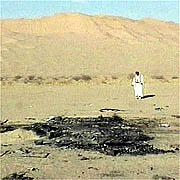 nt who planned the 1998 U.S. embassy bombings in east Africa was killed in an American airstrike, a Somalian official said Wednesday."I have received a report from the American side chronicling the targets and list of damage," said Abdirizak Hassan, the Somali president's chief of staff. "One of the items they were claiming was that Fazul Abdullah Mohammed is dead."Mohammed, 32, allegedly planned the attacks on the U.S. embassies in Kenya and Tanzania that killed 225 people.
nt who planned the 1998 U.S. embassy bombings in east Africa was killed in an American airstrike, a Somalian official said Wednesday."I have received a report from the American side chronicling the targets and list of damage," said Abdirizak Hassan, the Somali president's chief of staff. "One of the items they were claiming was that Fazul Abdullah Mohammed is dead."Mohammed, 32, allegedly planned the attacks on the U.S. embassies in Kenya and Tanzania that killed 225 people.